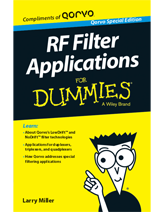Nine Key RF Filter Market Trends
February 25, 2016
The ever-increasing demand for limited frequency spectrum is creating new opportunities for filter applications. Traditional approaches to challenges such as temperature drift are no longer sufficient as frequency bands become more crowded and service providers attempt to fully utilize every bit of available bandwidth in the spectrum. Special applications for next-generation technologies, such as V2X (vehicle-to-infrastructure) communication standards and carrier aggregation, require innovative new filtering designs and technologies.
So what are some of the key market trends that innovative RF filters are addressing in today's modern LTE environment? Here are nine to remember:

- New frequency bands are increasingly packed closer and closer together. This can lead to a situation where the temperature drift of the filter response can be greater than the transition region between stopbands. Next-generation smartphones will demand higher performance and new technologies to support these new bands.
- Qorvo has developed LowDrift™ and NoDrift™ filter technologies to address these challenging temperature drift situations. NoDrift surface acoustic wave (SAW) and bulk acoustic wave (BAW) technologies help achieve a near-zero temperature coefficient of frequency (TCF) across -20°C to 85°C.
- In late 2013, a leading North American carrier required stringent standards for attenuation of the public safety band that is in between Band 13. Qorvo developed its NoDrift™ SAW technology in response to this new standard.
- Multiplexers — such as duplexers, triplexers, and quadplexers — combine multiple frequencies into a single device, which saves board space and simplifies radio frequency (RF) design. Multiplexers have a common input and are designed to achieve low insertion loss along with high isolation between the outputs.
- Carrier aggregation (CA) will allow carriers to use increased bandwidth to get higher data rates. Quadplexers are one common method to support closely spaced CAs.
- With more smartphones simultaneously supporting 2.4 GHz Wi-Fi and LTE Band 40, Band 7, Band 38, and Band 41, the need for Wi-Fi coexistence filters has skyrocketed. Qorvo's BAW coexistence filters offer significant advantages over traditional SAW and ceramic filters used for cellular Wi-Fi applications.
- Today's smartphones employ antenna diversity — using multiple antennas to receive the same signal — to support a broad range of wireless spectrum. Lower-end smartphones may use multiple discrete switches and diversity filters to maximize flexibility, while high-end devices may use integrated diversity modules to save precious board space.
- Stringent space and size constraints in small cell base stations are making it necessary for systems designers to choose SAW and BAW filters over ceramic or cavity filters. Qorvo is the world leader in offering a broad range of RF filters, duplexers, and multiband filter modules to serve pico cell market requirements.
- "Connected vehicles" are adopting all interface standards such as LTE, Wi-Fi, Bluetooth, GPS, and vehicle-to-infrastructure (V2X) for a wide range of services such as safety and infotainment. Qorvo filters enable the coexistence of this tightly packed spectrum without interference.
To learn more about RF filter technology, download our e-book, RF Filter Applications For Dummies®. You'll learn the basics of RF filters, temperature drift, acoustic filters and filter packaging technologies.
– Excerpted with permission from John Wiley & Sons, Inc., from RF Filter Applications For Dummies.
Have another topic that you would like Qorvo experts to cover? Email your suggestions to the Qorvo Blog team and it could be featured in an upcoming post. Please include your contact information in the body of the email.
